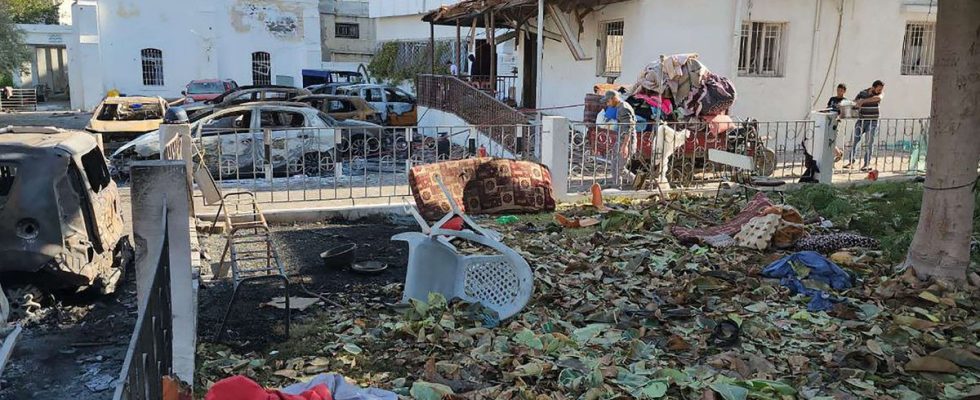Emotion and caution. Many European leaders condemned the strike which targeted a hospital in Gaza on Tuesday evening, killing hundreds of people. But everyone was careful not to attribute it, while Palestinians and Israelis mutually blame each other for the tragedy. “All light must be shed” on “the attack on the Al-Ahli Arabi hospital in Gaza which caused so many Palestinian victims,” Emmanuel Macron said on X (formerly Twitter). German Chancellor Olaf Scholz called for a “thorough investigation”. “All the facts must be established and those responsible must be held to account,” declared the President of the European Commission, Ursula von der Leyen.
But how can we determine with certainty and quickly what happened? Sealed off by the Israeli army since October 7, the Palestinian enclave is almost inaccessible to the international media, which must rely on photos and videos posted on the Internet by witnesses to work. “But connectivity in the Gaza Strip is quite limited. A few rare images of the scene, from civilians, were broadcast. There is a lack of accessible open source hardware. We must therefore take precautions, follow a methodology in the analysis, and pay attention to the degree of certainty with which we assert things. », explains to 20 minutes Baptiste Robert, expert in cybercrime and Osint (Open Source Intelligence), head of Predicta Lab. “We are in an information war,” he recalls. All information, even official ones, must be taken with caution and verified. »
Analysis of photos taken
“That doesn’t mean we can’t do anything,” he emphasizes. “There is evidence today that it is unlikely that it was an airstrike” that caused the destruction of the hospital. By analyzing certain photos posted on social networks, he noticed “that there is no crater” in the establishment’s parking lot. On the other hand, “there are a lot of cars destroyed, but mainly because of the fire that broke out. There are only three whose structure has really been destroyed.” To complete this photographic analysis work, Baptiste Robert considers it necessary “to send people on site to take samples, collect fragments of missiles or rockets if there are any, and to analyze the origin of the projectile fired “. “But it may already be too late, everyone can get on stage,” he observes.
Amnesty International teams are also investigating “the airstrikes carried out on Israel against Gaza” and the “massacre” perpetrated by Hamas on October 7, tells us Tcherina Jerolon, head of the conflicts, migrations and justice program in France. NGO. “We are carrying out field investigations at the places where violations are committed. This allows us to collect stories from direct witnesses or victims. This work also allows us to gather material evidence, for example by taking photos. This allowed us in certain cases to analyze weapons debris,” she explains to 20 minutes.
Digital investigation tools
Amnesty International also has an evidence laboratory, based in London, to “conduct remote investigations, particularly when security or access conditions are not met”. It is made up of multidisciplinary teams, “with specialists in visual data and weapons analysis,” explains Tcherina Jerolon. “They use digital investigation tools to work. They collect materials, such as satellite images, photos, videos. These elements, once analyzed, make it possible to determine whether or not we are in the context of a violation of international humanitarian law. » Their discovery then serves “to call the competent courts, here the International Criminal Court [qui a ouvert une enquête « sur la situation dans l’État de Palestine » le 3 mars 2021]to carry out investigations into specific facts with their own teams.”
At the same time, the French intelligence services could also be tempted to understand what happened. “I don’t think that the President of the Republic has commissioned the service specifically on this issue because, strategically, for France, it is a bit secondary,” explains to 20 minutes Olivier Mas, alias Beryl 614 on YouTube, a former DGSE executive, author of several books and videos on intelligence.
“We have already tried to attribute strikes”
On the other hand, his former colleagues who are in the area will most likely question their human sources. “Because when we are in the field, we want to know. And if we have the information, we will scrape it and pass it on. » This is work that the foreign intelligence service has already carried out in Syria in particular. The DGSE has techniques to analyze the trajectories of the projectiles fired. Those who are found are put under the microscope. “We tried to attribute strikes, to understand where they came from, if they had been launched by opposition forces or the regime,” says the former spy. The DRM (military intelligence directorate) also has images from its satellites, allowing it to carry out this task.

